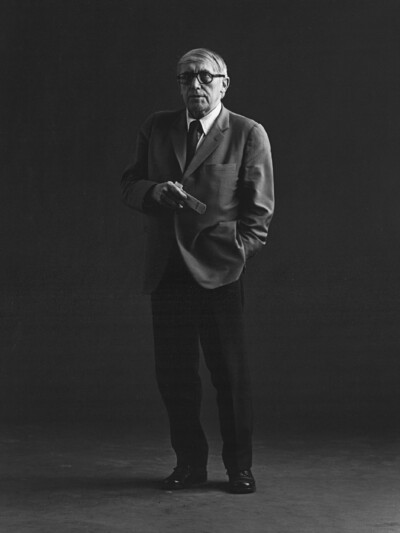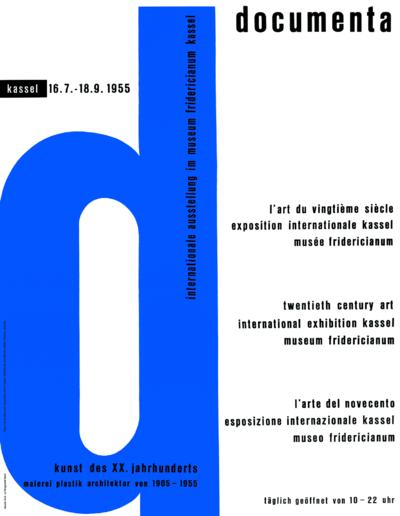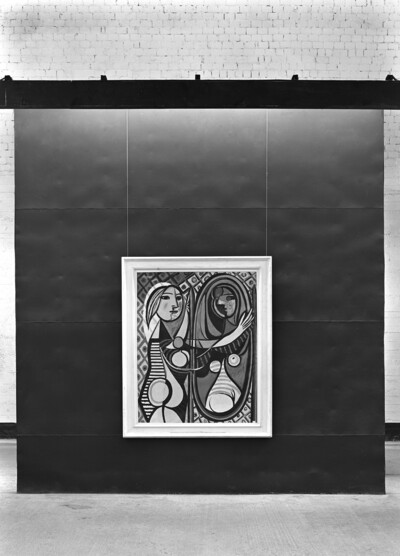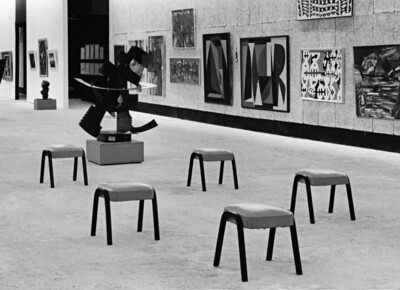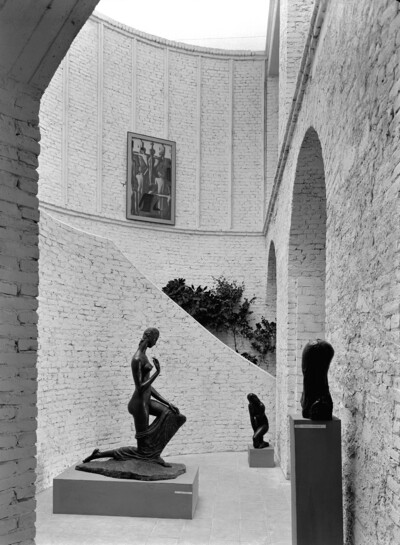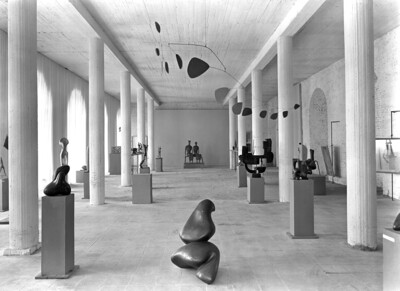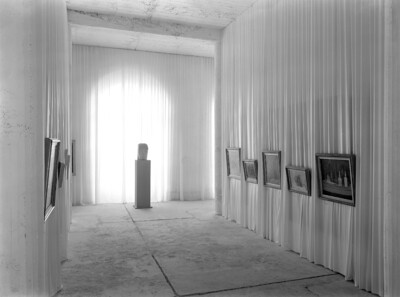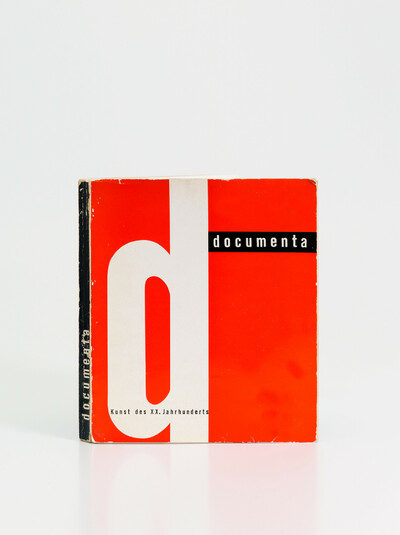Art of the XXth century. International exhibition
- Artistic Direction
Arnold Bode
- Venues
Museum Fridericianum
- Artists
148
- Visitors
130.000
- Budget
379,000 DM
The 1955 Federal Garden Show in Kassel, in which the rubble heaps of the Second World War were planted with rose beds, served Arnold Bode - painter, draughtsman, designer and teacher (banned from his profession in 1933), co-founder of the Kassel Art Academy in 1948 - as an opportunity to realize his long-cherished vision of a major international exhibition of modern art in Germany. The aim was to bring the avant-garde, which had been persecuted by the National Socialists, back to Germany and introduce it to a broad public with a cultural “backlog” - it was to be the first exhibition of modern art after the 1937 Degenerate Art Exhibition in Munich.
Bode’s role models were world art shows such as the Armory Show in New York. However, the aim of the Kassel event was not to provide an overview of the art of the first half of the 20th century, but rather to “make the roots of contemporary art visible in all areas”, according to Arnold Bode in the exposé. In other words, a genealogy of the present, generated from a mood between post-war trauma and the will to modernize. This included a photo series in the entrance area of the exhibition with examples of ancient, early Christian and non-European art as the foundation of European modernism, supplemented by photo portraits of the “masters” of the avant-garde, as well as an exhibition of architectural photography from 1905 to 1955 on the second floor of the rotunda of the Fridericianum.
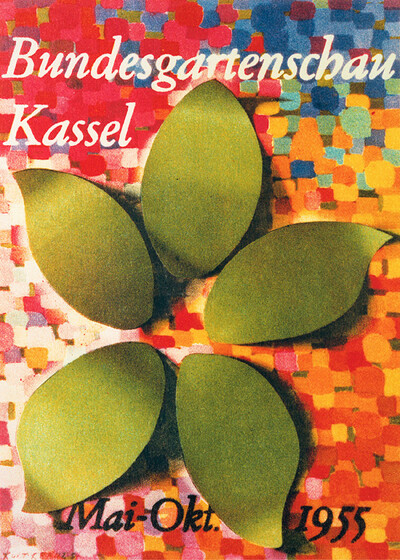
Ten years after the end of the war, Kassel, which had been almost completely destroyed by Allied bombs, was once again in a spirit of optimism. The Museum Fridericianum - the oldest museum on the European mainland, built in the spirit of the Enlightenment and completely burnt out in 1943/44 - had just been restored in a makeshift manner. A more fitting symbol for the German educational catastrophe that Bode wanted to repair with the documenta could hardly have been found. For the designer Bode, the unplastered, whitewashed walls provided a spectacular backdrop for his production. Among other things, he worked with Heraklith panels as structural cladding as well as wall drapes made of opaque black and white semi-transparent plastic, which served to regulate the incident daylight. In some cases, paintings were also hung directly on them. Another special feature were the metal steles, on which paintings were mounted as if floating in front of the wall or even standing freely in the room (such as the paintings by Futurist Carlo Carrà), which gave them a certain object-like, even essential quality. In Bode’s exhibition design, not only were works to be placed in relation to each other, but above all the viewer and the work of art. Wilhelm Lehmbruck’s Kneeling Woman (1911) in the heart of the Rotunda is highly symbolic - it had already been shown at the Armory Show in 1913 and at the Degenerate Art Exhibition in 1937. Paintings by Oskar Schlemmer from the 1920s hung above her in the stairwell of the Rotunda.
Henry Moore’s King and Queen (1952/53) were enthroned at the end of the sculpture hall on the first floor, with abstract sculptures by Hans Arp, Raymond Duchamp-Villon and Barbara Hepworth, among others, and mobiles by Alexander Calder loosely arranged in front of them. In the large painting room on the upper floor, Picasso’s Girl before a Mirror from 1932 hung opposite the painting Composition before Blue and Yellow by Fritz Winter, who is considered the father of abstract painting in Germany and was produced especially for the documenta in 1955 - a bold juxtaposition that was intended to symbolize Germany’s connection to the international art scene. Small stools served as seating, which - like the furniture in the “Café Picasso” on the second floor of the rotunda - were designed by Arnold Bode.
Other important painters included Max Beckmann (represented for example by the Perseus triptych, 1941), Giorgio de Chirico, Wassily Kandinsky, Paul Klee, Henri Matisse and Piet Mondrian. Female artists such as Paula Modersohn-Becker, Maria Helena Vieira da Silva and Sophie Taeuber-Arp were the exception. While the classic main currents of the avant-garde were also represented with Expressionism, Futurism, Constructivism and Cubism, it is noticeable that explicitly political, subversive positions such as Dada, namely John Heartfield or George Grosz, were missing. A total of 670 works by 148 artists from six nations were shown, mainly from Germany, France and Italy. Bode was assisted in the conception of the content by a working committee, headed by the renowned art historian Werner Haftmann as the conceptual mastermind, who advocated the thesis of the continuity of the development of an art oriented towards the abstract. This tendency was to continue and intensify four years later at documenta 2 - although there was no talk of this in 1955.
It can at least be assumed that Bode was already thinking about a cyclical continuation of his international exhibition. The overwhelming public success of documenta, with 130,000 visitors in 100 days, certainly paved the way for this.

Gallery
Artists
a
- Albers, Josef
- Armitage, Kenneth
- Arp, Hans
- Auberjonois, René Victor
b
- Balla, Giacomo
- Bargheer, Eduard
- Barlach, Ernst
- Basaldella, Afro
- Basaldella, Mirko
- Baumeister, Willi
- Bazaine, Jean René
- Beaudin, André
- Beckmann, Max
- Bill, Max
- Birolli, Renato
- Bissière, Roger
- Blumenthal, Hermann
- Boccioni, Umberto
- Bombois, Camille
- Braque, Georges
- Butler, Reg
c
- Camaro, Alexander
- Campendonck, Heinrich
- Campigli, Massimo
- Capogrossi, Giuseppe
- Carrà, Carlo DalmazzoCarrà, Carlo
- Casorati, Felice
- Cassinari, Bruno
- Chadwick, Lynn
- Chagall, Marc
- Corpora, Antonio
- Crippa, Roberto
d
- De Chirico, Giorgio
- De Fiori, Ernesto
- Delaunay, Robert
- De Pisis, Filippo
- Derain, André
- Despiau, Charles
- Dix, Otto
- Doesburg, Theo van
- Duchamp-Villon, Raymond
- Dufy, Raoul
e
- Ernst, Max
f
- Faßbender, Joseph
- Feininger, Lyonel
- Fuhr, Xaver
g
- Gabo, Naum
- Gilles, Werner
- Glarner, Fritz
- Gonzalez, Julio
- Grieshaber, HAP
- Gris, Juan
h
- Hartung, Hans
- Hartung, Karl
- Heckel, Erich
- Heiliger, Bernhard
- Heldt, Werner
- Hepworth, Barbara
- Herbin, Auguste
- Hofer, Karl
j
- Jawlensky, Alexej
k
- Kandinsky, Wassily
- Kasper, Ludwig
- Kirchner, Ernst-Ludwig
- Klee, Paul
- Kokoschka, Oskar
- Kupka, Frantisek
l
- Lardera, Berto
- Laurens, Henri
- Lehmann, Kurt
- Lehmbruck, Wilhelm
- Léger, Fernand
m
- Macke, August
- Magnelli, Alberto
- Maillol, Aristide
- Manessier, Alfred
- Marc, Franz
- Marcks, Gerhard
- Marini, Marino
- Masson, André
- Mataré, Ewald
- Matisse, Henri
- Meistermann, Georg
- Mettel, Hans
- Meyer-Amden, Otto
- Miró, Joan
- Modersohn-Becker, Paula
- Modigliani, Amedeo
- Mondrian, Piet
- Moore, Henry
- Morandi, Giorgio
- Moreni, Mattia
- Morlotti, Ennio
- Mortensen, Richard
- Muche, Georg
- Music, Zoran
- Müller, Otto
- Münter, Gabriele
n
- Nay, Ernst Wilhelm
- Nesch, Rolf
- Nicholson, Ben
- Nolde, Emil
p
- Pechstein, Max
- Pevsner, Antoine
- Picasso, Pablo
- Pignon, Edouard
- Purrmann, Hans
r
- Ritschl, Otto
- Roeder, Emy
- Roesch, Kurt
- Rohlfs, Christian
- Rouault, Georges
- Rousseau, Henri
s
- Santomaso, Giuseppe
- Scharff, Edwin
- Schlemmer, Oskar
- Schmidt-Rottluff, Karl
- Schneider, Gérard
- Schwitters, Kurt
- Scipione, Gino Bonichi
- Scott, William
- Seraphine, Louis de Senlis
- Severini, Gino
- Singier, Gustave
- Sironi, Mario
- Soulages, Pierre
- Stadler, Toni
- Sutherland, Graham
t
- Taeuber-Arp, Sophie
- Tal-Coat, Pierre
- Trier, Hann
- Trökes, Heinz
u
- Uhlmann, Hans
v
- Vasarely, Victor
- Vedova, Emilio
- Viani, Alberto
- Vieira da Silva, Marie Hélène
- Villon, Jacques
- Vivin, Louis
- Vlaminck, Maurice de
- Vordemberge-Gildewart, Friedrich
w
- Werner, Theodor
- Wiemken, Walter Kurt
- Wimmer, Hans
- Winter, Fritz
- Wolff, Gustav H.
- Wols (Schulze, Wolfgang)
Artistic Director
Arnold Bode
born 1900 in Kassel, died 1977 in Kassel
1919 - 1924
Studied painting and graphics at the Kunstakademie Kassel, Kassel1922 - 1929
Art exhibitions of modern art in the Orangery in Kassel1925
Founding of the Kassel Secession and the artists' group Die Fünffrom 1926
Freelance painter and draughtsman1929
Joins the SPD. Member of the SPD until 19771930
Lecturer at the Städtisches Werklehrer-Seminar, Berlin1931 - 1933
Deputy Director of the Werklehrer-Seminar, Berlin1933
Removed from office by the National Socialists. Banned from working as an artist1934
Internal immigration in Kassel1945
American prisoner of war. Returns to Kassel after releasefrom 1945
Development of project plans for a major international art exhibition. Founding of the Society of Western Art of the 20th Century1948
Re-establishment of the Kassel Art Academy, which had been closed in 19321950 - 1955
Work as an interior and furniture designer1955
Artistic director of the first documenta in Kassel1959
Artistic director of documenta 2, Kassel1964
Artistic director of documenta 3, Kassel1968
Artistic director of documenta 4, Kassel
Awards (selection):
1974
Awarded the Grand Cross of Merit of the Federal Republic of Germany2015
Hessian Culture Prize for his work as Artistic Director of documenta 1-4 (posthumously)
